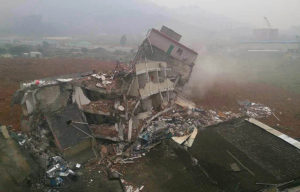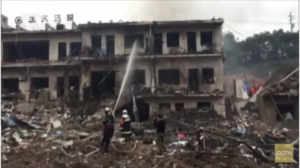After last year’s Tianjin mega-explosion and the Shenzhen landslide, the Chinese government assured an anxious population that it would strengthen environmental regulation and safety measures across the board. Yet China continued to experience a steady string of environmental disasters in 2016.
The slew of environmental incidents, which included a coal-fired power plant explosion, chemical fires, factory fires, and the destruction of a residential compound caused by improperly stored explosives, lacked the visibility and media attention of the previous year’s major disasters, in large part because they occurred outside major coastal economic hubs, where public scrutiny is greatest. According to data collected by Greenpeace, China averaged twenty-nine chemical accidents per month from January–September 2016, killing 199 and injuring 400 in total. Many other incidents go unreported, or the news about them is swiftly censored before they gain attention.
One exception was when students at Changzhou Foreign Language School 常州外国语学校 in Jiangsu began falling sick after moving to a new campus in April. A public investigation ensued into whether the students’ failing health was connected to the fact that the campus was built on the location of a former chemical factory. China Central Television (CCTV) broadcast a report of the allegations, and the financial media group Caixin 财新 published a story claiming that toxic waste had been buried in 2010 under the current site of the school. The incident stirred public outrage. While local government and school officials continued to dispute the allegations, the central government responded by opening an official investigation. Chinese environmentalist Ma Jun 马军 compared the public response to the outrage surrounding the Love Canal disaster of 1978 in the US. Love Canal was a residential community in upstate New York that was built on top of 21,000 tons of toxic waste dumped in the 1940s and 1950s. In the 1970s, chemical waste started to leach into the community, causing a public health crisis and one of America’s defining environmental tragedies. The Love Canal incident led to the adoption of Superfund, one of the major US regulations dealing with toxic site cleanups.
In general, public oversight of such incidents remains minimal. For example, after scores of people died in a building explosion near the city of Yulin in Shaanxi, which was likely caused by the improper storage of explosives, censors swooped in and wiped nearly all coverage of the event from the Internet. Decades of rapid economic growth combined with a national–local regulatory implementation gap have led to corner-cutting, and issues of poor oversight. Economic development has also turned China into one of the largest producers of petrochemicals in the world, as well as of other volatile chemicals used in the textile, mining, and automotive industries. The improper storage of these substances, often in densely populated urban areas, as well as the sort of budgetary practices that increase the likelihood of accidents, will most likely continue to challenge Chinese regulators in protecting environmental and human health in the years to come.
Timeline of Environmental Disasters in 2016
- 12 April, Jingjiang, Jiangsu: Improperly stored chemicals turned Jiangsu Deqiao Storage Company’s warehouse into a fiery inferno that could be seen for miles. Rescue workers at the scene were evacuated before the fire was extinguished, due to strange odours and chest pains. Details on the total number dead or injured have not been published.
- 18 April, Changzhou, Jiangsu: Scattered cases of student illness swiftly escalated into a school-wide health crisis after students at Changzhou Foreign Language School moved to a new campus, which was built on a former chemical plant. A total of 493 of 641 students were diagnosed with conditions from bronchitis and thyroid abnormalities to lymphoma and leukemia.
- 11 August, Danyang, Hubei: At least twenty-one people died when a high-pressure steam tube ruptured in a coal-fired power station.
- 24 October, Yulin, Shaanxi: An explosion ripped through a three-story pre-fab residential building, leaving a crater surrounded by piles of rubble. The explosion killed at least fourteen people and left more than 156 injured. Local government officials quickly blamed the explosion on the illegal storage of explosives, but did not divulge any more details. Authorities from the Municipal Committee vowed to carry out a probe into the safety standards of other facilities in the city and punish those responsible, though further details were not forthcoming.
- 31 October, Jinshangou, Chongqing: A gas explosion in a privately owned coal mine trapped thirty-three coal miners. All died before rescue workers could reach them.
- 8 October, Lu’an, Anhui: Fifty workers at the Qinjiaqiao Munitions Factory died after an explosion. Officials refused to comment on the cause.
- 9 October, Zibo, Shandong: The explosion of an ammonia tank at the Zhoucun Jiazhou Power Company left five dead and at least nine injured.
Notes
‘China leaders urge professional Tianjin response’, Xinhuanet, 20 August 2015, online at: http://news.xinhuanet.com/english/2015-08/20/c_134538288.htm
‘China averaged 29 chemical accidents per month so far this year — Greenpeace’, Greenpeace, 21 September 2016, online at: http://www.greenpeace.org/eastasia/press/releases/toxics/2016/China-averaged–29-chemical-accidents-per-month-so-far-this-year—Greenpeace/
‘China’s toxic school: o cials struggle to contain uproar over stick students’, The Guardian, 19 April 2016, online at: https://www.theguardian.com/world/2016/apr/19/chinas-toxic-school-officials-struggle-to-hold-back-uproar-over-sick-students; and Gilbert Cruz, ‘And the Earth cried: love canal’, Time, 3 May 2010, online at: http://content.time.com/time/specials/packages/article/0,28804,1986457_1986501_1986441,00.html
David Bundurski, ‘Media quiet follows blast of Yulin coverage’, China Media Project, 25 October 2016, online at: https://medium.com/china-media-project/silence-follows-burst-of-interest-in-yulin-blast-572d4a0047bc
Zhang Honghong, ‘Yulin informed that safety procedures have been deployed to rectify issues related to the Fugu explosion 榆林通报府谷爆炸事件有关情况部署安全整顿’, Yulin Daily, 1 November 2016, online at: http://xian.qq.com/a/20161101/014143.htm





